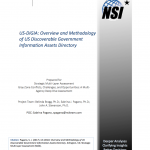US Discoverable Government Information Assets Directory
US-DiGIA: Overview and Methodology of US Discoverable Government Information Assets Directory.
Author | Editor: Polansky (Pagano), S. (NSI, Inc.).
Executive Summary
The United States Government possesses a vast store of information assets that can be leveraged to inform a variety of problem sets, and can be used by a wide range of governmental actors in the formation and execution of whole-of-government strategies. To enable this goal, however, these assets first must be made accessible in a single source that catalogues the information that is held.
What is US-DiGIA?
The US “Discoverable Government Information Assets” Directory (US-DiGIA for short) resource catalogues the discoverable information assets (practical information, data, analysis, and subject matter expertise) relevant to national security and foreign policy held by the USG in a simple, easy- to-use searchable directory.
The US-DiGIA Directory is focused on “discoverable” information assets—that is, those information assets that are both open source (unclassified) and made available and/or identified as information assets held by the organizations that the NSI team examined. By focusing on which information assets are “discoverable,” this mapping does not claim to represent the true distribution of information assets across the whole-of-government, but instead captures what can be observed and obtained through unclassified channels—and thus potentially accessed via an interagency process.
US-DiGIA compiles and categorizes the information assets of 236 offices across 221 combined US government departments, agencies, and corporations (referred to collectively as “USG organizations”). US-DiGIA catalogues 1,305 unique information topics culled from these combined sources, and accounts for 1,980 total information topics (as some offices work on overlapping issues).
To create the US-DiGIA Directory, the NSI team developed a methodological process (detailed below in the section entitled, “US-DiGIA Mapping Methodology Process”) for taking the unstructured data culled from USG organization websites examined and translating them into information assets. The NSI team created an extended record2 of data sources, including mission statements, links to documents and tools, related web pages, and contact information. On the foundation of this rich source of information, the NSI team in turn developed the US-DiGIA Directory.

Comments